Lots of people in health and fitness roll their eyes at the idea that eating healthy is hard. The stark reality they’re missing: For many folks, constraints with time, money, transportation, etc. make good nutrition seem out of reach. Read on for some hard truth about healthy eating.
- Want to listen instead of read? Download the audio recording here…
++++
“Experiential” writing is very popular in journalism, including in the health and fitness field.
Morgan Spurlock’s “Super Size Me” documentary immediately comes to mind. (Spoiler alert: He gained weight and ruined his health by eating an ungodly amount of food…exclusively from McDonald’s.)
Somewhat ironically, so does John Cisna’s book, My McDonald’s Diet. (Another spoiler: He lost weight and improved his health eating a sensible amount of food…exclusively from McDonald’s.)
I decided to contribute to the genre by doing something called the Food Stamp Challenge. Wait…what?
Yep, the Food Stamp Challenge. It’s a popular self-experiment where you try to eat well on the budget allotted by the Supplemental Nutrition Assistance Program, or SNAP.
Now, lots of people have used the Food Stamp Challenge as a vehicle to either prove or refute the notion that eating healthy (on a budget) is hard. Others have used it to raise awareness for food insecurity specifically or for poverty in general.
As for me, I was more interested in the mechanics. I wondered: “What, exactly, does it take to eat nutritious food consistently when you’re faced with constrained resources?” Let’s find out.
The ground rules for my experiment were:
Start with a U.S. food-stamp amount of money.
How much is that? Estimates range from $29 per family for the whole week to $4.80 per person per day to $2.38 per person per meal. With that wide range in mind, I settled somewhere in the middle: $4 per person per day. Since there are 2 people in my household, my “food stamp” budget was $40 a week.
Hold myself to minimal shopping trips.
Who’s got time to shop around at dozens of stores looking for the best deal on every single item? Wanting to be realistic, and true to the spirit of the challenge, I confined myself to one market and as few trips as possible.
Buy the cheapest form of everything.
With a limited budget of only $40 for the week, it became crucial to find the best individual deals, within reason. No organic silliness or buy-the-first-one-because-I’m-bored allowed.
Don’t buy food I’m not going to eat or preserve.
I am highly uncomfortable with food wastage on moral grounds. But, in this case, we can add thrift to my motivation. So I made sure to shop with waste in mind.
My Food Stamp Challenge.
You should know: I’m a competitive man. So I wanted to get this right. That’s why I was actually a little nervous looking down at Andrew Jackson’s angry face.

Was I going to win the challenge?
Or would I end up looking as silly as Gwyneth Paltrow when she tried this?
Only time would tell…
For now, meet Haymarket, in Boston.
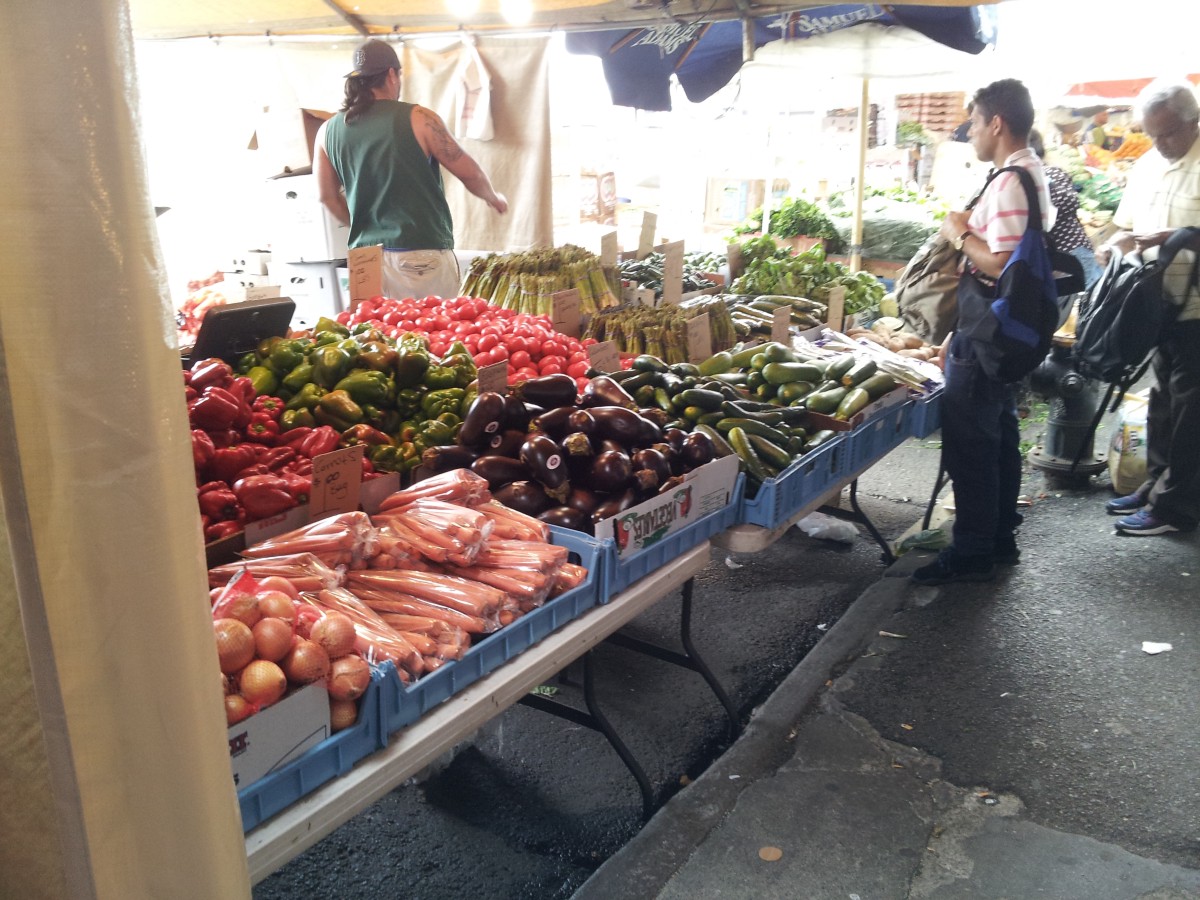
It’s an outdoor market that sells excess foods left over from commercial purchases. It’s also easily the cheapest place in the city to buy fresh fruit and vegetables, which are a large part of my diet.
It’s cramped, and large, and noisy, and it smells a bit. There’s no one selling essential oil. Or dreamcatchers. Everyone sells food out of styrofoam buckets or out of a cardboard box.
Everyone is in a hurry. And they take cash only.
In a nutshell, it’s the perfect place for this challenge.
Now, meet $40 worth of food.
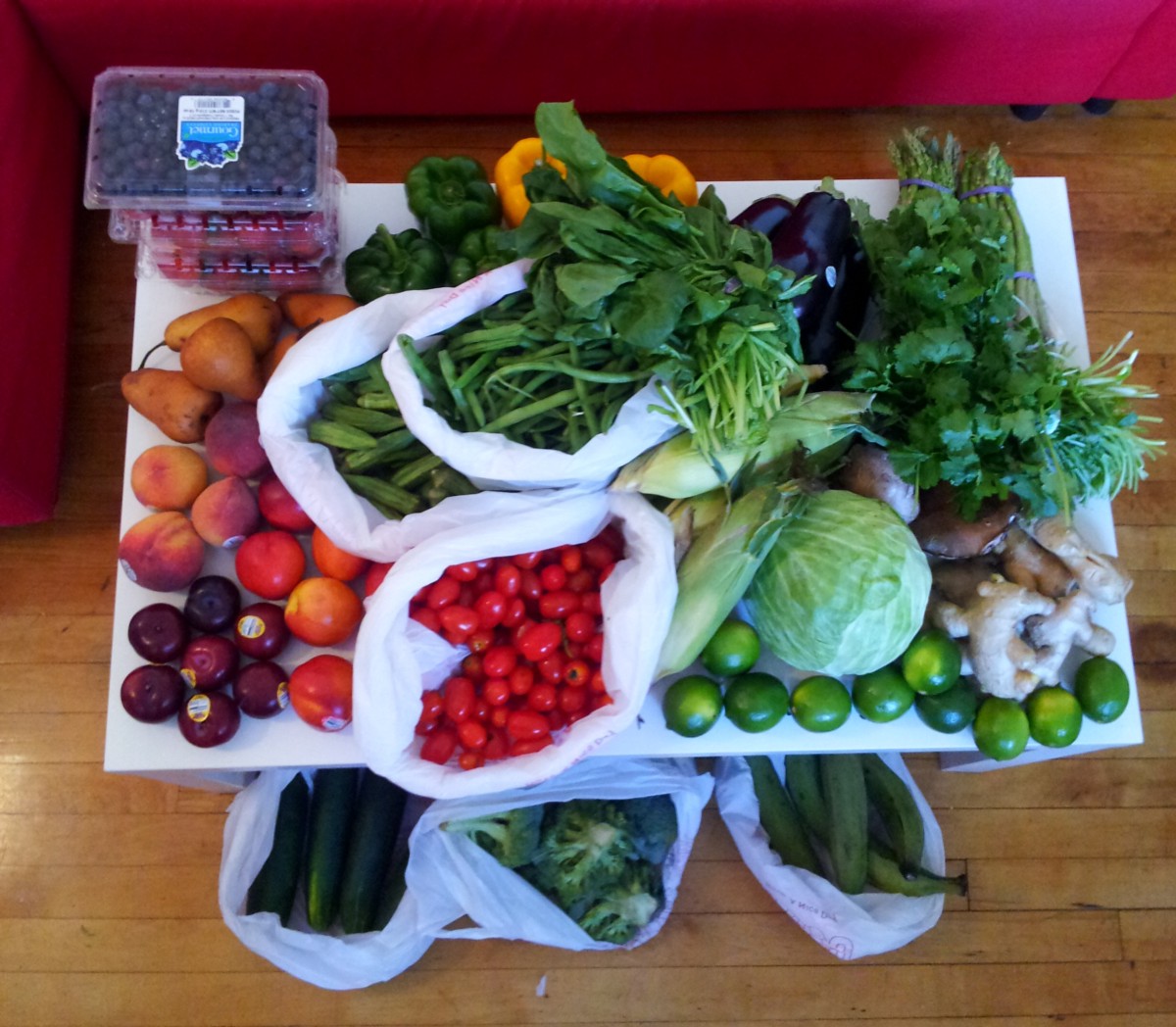
In an approximate clockface, I brought home:
| 4 green peppers | 2 yellow peppers |
| 2 lbs of green beans | a bunch of spinach |
| 4 eggplants | 2 bunches of coriander |
| 2 bunches of asparagus | 1 lb of portobellos |
| 2 lbs of ginger | 10 limes |
| a cabbage | 4 ears of corn |
| 1 lb of fresh baby tomatoes | 4 lbs of okra |
| 7 plums | 7 nectarines |
| 4 peaches | 5 pears |
| 2 lbs strawberries | 1 lb blueberries |
| 4 cucumbers | 4 lbs broccoli |
| 4 plantains |
Now, if you’re thinking “Where’s all the normal food?” … well, you’d be right.
I screwed up. I hadn’t planned properly so I didn’t buy anything that was *really* cheap: Potatoes, onions, tomatoes, carrots, or similar. I also didn’t get flour, or pasta, or eggs, or meat, or milk. Oops.
So, we ate all this food (which took a lot more than a week, actually). And then I went and did the Food Stamp Challenge again, but properly this time.
I spent every cent in the budget, ate more than a few potatoes, and even consumed animal protein this time (eggs and inexpensive cuts of pork).
So, the moment of truth…what happened?
Well, after my initial screw-up, I “won”. My partner and I ate well. And the Food Stamp Challenge ended up being little more than the Food Stamp Minor Inconvenience.
But rather than get self-righteous about how easy it is to eat well on a budget, it’s important to own that:
- I only won because I have several “hidden” advantages many others don’t.
- I’m pretty sure I got disqualified.
Read on for more…
6 reasons why healthy eating is hard.
Reason #1:
You need a good market.
When I say “market”, I mean a place where you can buy affordable, fresh, whole food. Of course, if you’re on a budget, this market would offer non-organic, non-special, non-biodynamic fresh food…like Haymarket, where I shopped.
Plenty of countries celebrate this market concept as there’s a reserved word for it all over the world: For example, in Germany, it’s ‘wochenmarkt’; in Poland, it’s ‘rynek’; in Thailand, ‘talat’.
Of course, in the absence of that sort of market, you’d have to shop at a supermarket (which sells traditional grocery store or market products, plus household products) or a hypermarket (which is a supermarket, plus a department store). In both cases, you pay more for the convenience of having everything you could need in one location.
Since I live in Boston, I have access to every type of market. But, what if you had access to none of the above?
Yeah, that happens. In fact, health research has recently been focusing a lot on what happens in communities where there aren’t just reduced options for buying fresh food, but none.
These locations are referred to as food deserts, neighborhoods or local areas that combine a) economic disadvantage with b) lack of access to regularly priced fresh food. And the research on them is pretty clear: Overweight and obesity is associated with lack of fresh food access.
So let’s get real: For many communities, the idea that “eating healthy isn’t that hard” is total rubbish. Research suggests it’s hard indeed.
But that’s just one reason why eating healthy is hard. Because even if you have access…
Reason #2:
You need time to shop.
When I did the Food Stamp Challenge, I went shopping in the middle of the day on a Friday.
My academic work is usually flexible, and obviously so is writing. So, I just stood up one day and said, You know what? I fancy writing something about a big bag of fruit and vegetables.
That’s probably not typical of other people’s work.
- Some folks work 50 hours a week and then rush home to relieve the sitter.
- Others commute two hours every day.
- Others are constantly having to decide between grocery shopping and getting some exercise or helping their children with homework.
- Others have two jobs…maybe a day job and a night job.
So where’s your shopping time now?
There are a million other examples, and naturally there’s also research. This phenomenon even has its own name: time poverty.
In fact, in consumer surveys, time is as big a barrier as cost when it comes to eating a healthy diet.
Reason #3:
You need to transport all the food.
Let’s say we have a market to go to, and the time to go there. Big assumptions for most of the world’s population…but let’s be generous and offer them up freely.
So what’s next?
Well, we have to get to the market and haul all that fresh food home. Which means you need a car or reliable public transport. (That costs money.) And you need to be able to carry the groceries. (That takes strength and energy.)
Let me explain.
The odds are very good that I’m bigger than you. (I’m 6’3” and 255 pounds.)
Now, here’s what my week’s worth of fresh food looks like next to me:

You know that obsession people have with carrying all the shopping inside from the car in one hit? It’s cute and everything. But imagine you’re a tired working mother, or you have a bad back, or you’re shopping with 3 small kids to look after, or you’re 5 foot 2?
While I can get all hairy-chested about how I can carry more shopping bags than you (and I can carry more shopping bags than you), that isn’t the point.
The point is that fresh food is heavy.
On my second go with the Food Stamp Challenge, I bought 10 pounds of potatoes and 5 pounds of onions. I bought tomatoes. I bought plantains. I bought a melon.
My enormous shopping bag quickly filled up. The handle started to cut into my fingers. Eventually, there was too much food to even maneuver around other people at the market. I half-carried, half-dragged it to a nearby alleyway…and I called an Uber.
Fifteen minutes later we were home, and I carried it all upstairs (four floors) and promptly fell in a crumpled heap.
(I’m pretty sure paying someone to drive you home disqualifies you in the Food Stamp Challenge).
So, yeah, what if you don’t have a car, because you can’t afford one? Or because you live in the city and can’t afford to park one? What if you struggle to get up the steps of the bus, let alone carry groceries up them? What if you’re 80 years old?
Sometimes shopping for, and transporting, fresh food will feel like more than you’re capable of. And it may well be.
So maybe the convenience store will do. Sure, they only have cinnamon rolls and frozen dinners. But the dinners have frozen vegetables, and that’s healthy. Right?
Or, should you just order fast food? Or takeout? Just this once? You’ll cook tomorrow, you promise. Which brings us to the next challenge…
Reason #4:
You need time to cook.
After gleefully buying half the market and then suffering the indignity of not being able to get myself home, I began the more strenuous, boring, and involved task of turning those foodstuffs into food.
If everything is fresh, then most of it needs to be cooked or preserved quickly.
The tomatoes were wonderful and super-ripe, so they needed to be oven-roasted and stored. The okra didn’t like the bag it was in, so we had to cook it the first night. And we sure ate a lot of fruit in the first few days. Ripe fruit doesn’t keep!
I pickled jalapeno chillies in vinegar, and dressed and froze layers of berries. Ginger, by the way, stores remarkably well peeled, sliced, placed in vodka and refrigerated. And it turns out plantains keep forever.
In short, more time and labor. Not much respite for the modern 50 hours/week worker. Another black mark to the time poverty column.
Reason #5:
You need equipment, seasonings and ancillary ingredients.
Here’s an example of how I used my super-cheap vegetables. In brackets, I’ve included prices and histories for the equipment. I’ve also numbered the extra ingredients you need.
SIMPLE, FAST VEGETABLE CURRY
- Sharpen knives [$35, Messermeister ceramic rod], clear workspace.
- Finely dice an onion [carbon steel knife, bought from an obscure toolstore, about $20; regular cutting board, $8].
- Peel and grate [Microplane, $25] 2 inches of ginger.
- Finely chop 5 cloves garlic.
- Heat cooking oil (1) in a pan [cast iron, bought in Sydney about 10 years ago, about $200].
- Cook ½ tsp of white sugar (2) until it caramelizes [$2, bamboo spoon], then cook the onion until it’s soft.
- Add a teaspoon of grated turmeric (3), lots of kashmiri chilli (4), some very ripe tomatoes, and a little water.
- Combine it all, turn heat down to medium-low, add about 4 cups of any non-leafy vegetables you want curried [vegetable peeler, $4].
- To finish, adjust salt (5), then add about a tablespoon of cream (6), and lots of garam masala (7).
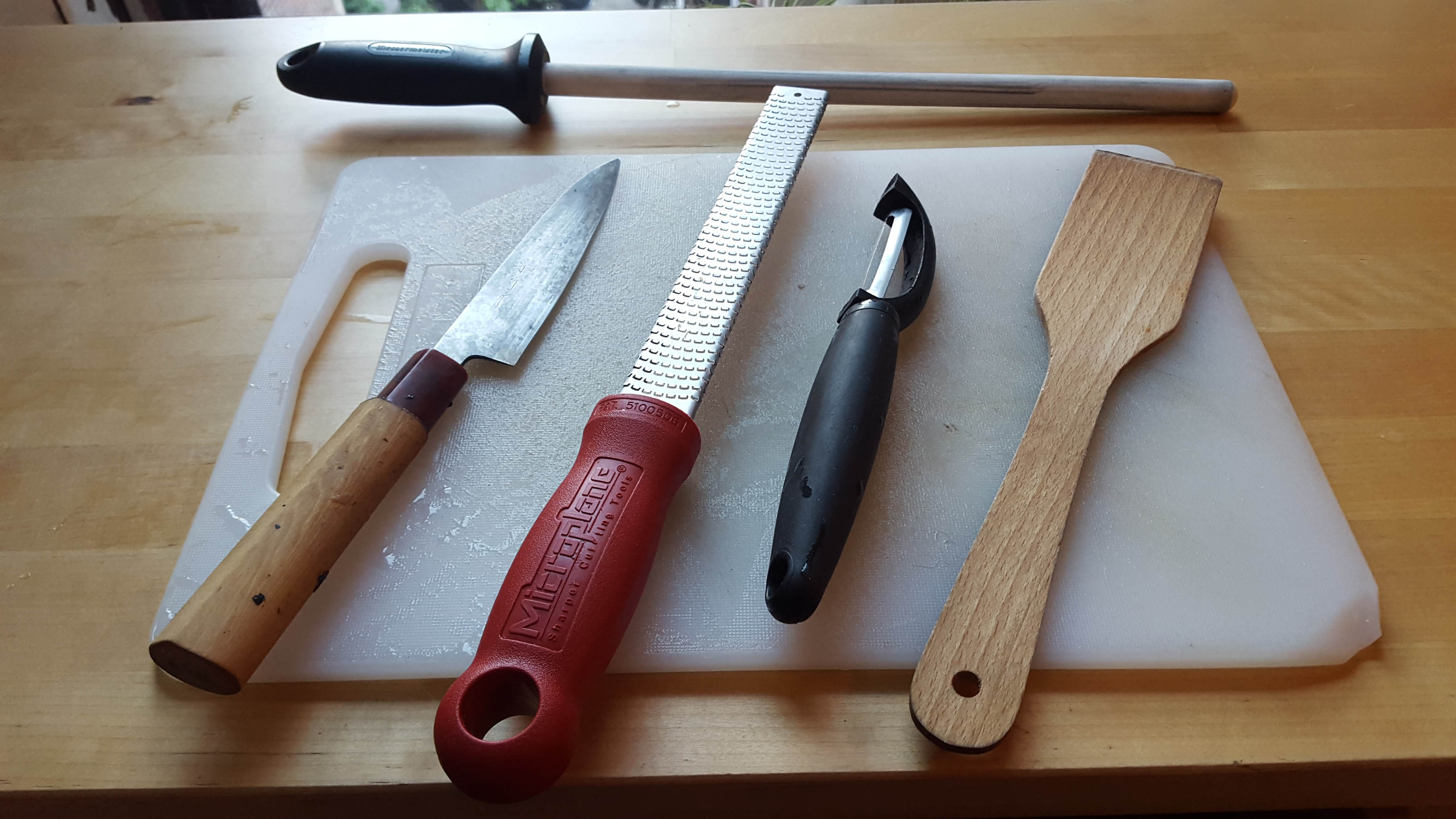
That’s six pieces of equipment [~$275] I already had on hand. None are particularly groundbreaking, but if you wish for the cooking process to proceed quickly, straightforwardly, and without frustration or stress, they’re almost all mandatory.
It’s also seven extra ingredients that allowed me to successfully ‘use’ my cheap foodstuffs (i.e. to make them taste really good so I wouldn’t be tempted toward a more palatable but also more expensive/unhealthy option).
Of course, you could cut a few corners here and there, but certain things are inalienable. It’s hard to cut vegetables on a ceramic plate with a breadknife. It’s hard to eat a curry without salt. It’s hard to cook some types of rice without a rice cooker.
And before you think: Dear me, that’s not a normal uncomplicated recipe at all, let me assure you that this is a perfectly normal, easy, and modified-to-make-it-even-easier recipe that any Indian aunty would dismiss — not at all ironically — as “not trying hard enough”.
Which brings us to…
Reason #6:
You need cooking skills.
Here’s a fun game you can play. And by fun, I mean really quite depressing.
Find a Millennial, and take away their smartphone (don’t worry, it’s only temporary). Now that they can’t Google the answer, ask them: “What is ‘home economics’?” Often, they don’t know.
In case you don’t know the meaning of “home economics”: It’s a subject they used to teach at school where you learn to manage a household. And while that means you learn to parcel up your garbage and wipe down a countertop, it’s a course mostly about learning to cook.
Yes, that was a real thing. But it’s not anymore.
We are now at least two generations removed from people who grew up in a house where people cooked regularly, and where people were taught to cook at school.
These skills are passed on and socially reinforced. In other words, if you’re just ordinary at cooking, chances are your kids will be even worse.
Recently, there has been some good evidence to show that teaching people to cook can improve ALL of the following:
- Attitude toward food and cooking
- Confidence
- Fruit and vegetable intake
- Food purchasing habits
- Social interaction at home
In the end, it takes some experience and skill to chop up a bunch of foodstuffs and put them together without it tasting awful. Especially if you’re trying to eat on a budget.
Without that skill, the idea that “eating healthy is easy” feels extra absurd.
My failure, and lessons I learned.
I took the Food Stamp Challenge, and — technically — I won. At least, if winning is spending the right amount of money, and eating well.
But as far as this being realistic is concerned, I failed. Badly.
It’s thanks to certain non-food advantages I already have that allowed me to be successful. In many respects, it’s these factors that determine how well one will eat.
You see, everyone knows fruit and vegetables are good for you. Everyone knows it’s easy to eat too much starch and sugar in one sitting. Everyone intuitively understands the idea of portion control.
Yet, in modern life, many stars have to align for this to translate into “eating healthy”. Which means, despite what rah, rah personal trainers and other fitness fanatics often say:
It’s not always easy to eat well.
And maybe it’s okay if we just started admitting it.
What to do next:
Some tips from Precision Nutrition
Whether you’re trying to figure out how to eat in the context of your busy, hectic, time-strapped life, or you’re a fitness pro whose clients may be struggling with these challenges, it’s okay to stop pretending eating well is always a breeze.
When constrained resources make eating healthy a challenge, consider these strategies.
Embrace the struggle.
Unless you’re affluent, and/or your career involves you getting paid to be in shape, modern life will sometimes make it challenging to eat well.
The first step is to accept this in a sober, realistic way. Then you can focus on finding strategies to work around the challenges.
Build a kitchen toolkit.
With a proper kitchen set-up you’ll be able to cook most things, even if you don’t consider yourself “a chef”. To find the best price, shop around on Google and Ebay.
The basics:
- Casserole dish (Pyrex is best)
- Small assortment of steel bowls (scuffed and beat-up is fine)
- Stainless steel chef’s knife (get a reasonable secondhand one for $5-$10)
- Knife sharpener (ceramic rod or stone)
- Cast iron skillet (you can get a decent Lodge skillet for $20; must be seasoned)
- Small assortment of wooden / bamboo tools
- Fine microplane
- Wooden cutting board
- Vegetable peeler
Schedule your shopping and meal prep.
Build grocery shopping and in-advance meal prep into your weekly calendar so you’re not always scrambling (and opting for less-nutritious convenience meals).
This also helps you use fresh food before it goes bad, saving you money in the process.
Simplify cooking.
Meals don’t need to be elaborate to taste delicious. And while cooking skills don’t develop overnight, putting tasty food on a plate is by no means rocket science.
Here’s a guide for creating basic, well-balanced meals with flavor profiles you’re probably familiar with.
Prioritize stress reduction
Eating well consistently requires resources — money, time, energy, and skill development. These requirements can be challenging when you already have a lot to worry about.
Reducing your total stress load may make more room in your life for the effort of high-quality nutrition (and allow your body to make better use of all those great nutrients).
Go for a walk, relax in the park, spend quality time with family and friends, do some yoga, goof around with your kids, read a book, or get your partner to give you a massage.
Be sensitive
If you’re struggling to eat the way you’d like, cut yourself some slack. It’s OK to ask for help.
If you’re a fitness or health pro who’s been known to say “healthy eating is easy” or “people just aren’t trying hard enough” — stop and reexamine.
Healthy eating requires more effort and organization than most people think. Do some outreach. Volunteer. Learn about the people in your community who are struggling and could use your support.
References
Click here to view the information sources referenced in this article.
If you’re a coach, or you want to be…
You can help people build sustainable nutrition and lifestyle habits that will significantly improve their physical and mental health—while you make a great living doing what you love. We'll show you how.
If you’d like to learn more, consider the PN Level 1 Nutrition Coaching Certification. (You can enroll now at a big discount.)

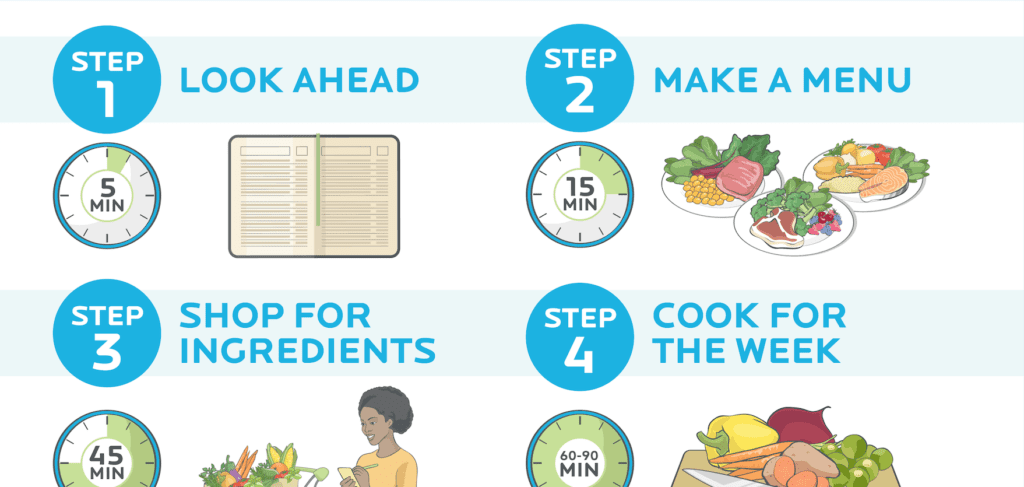
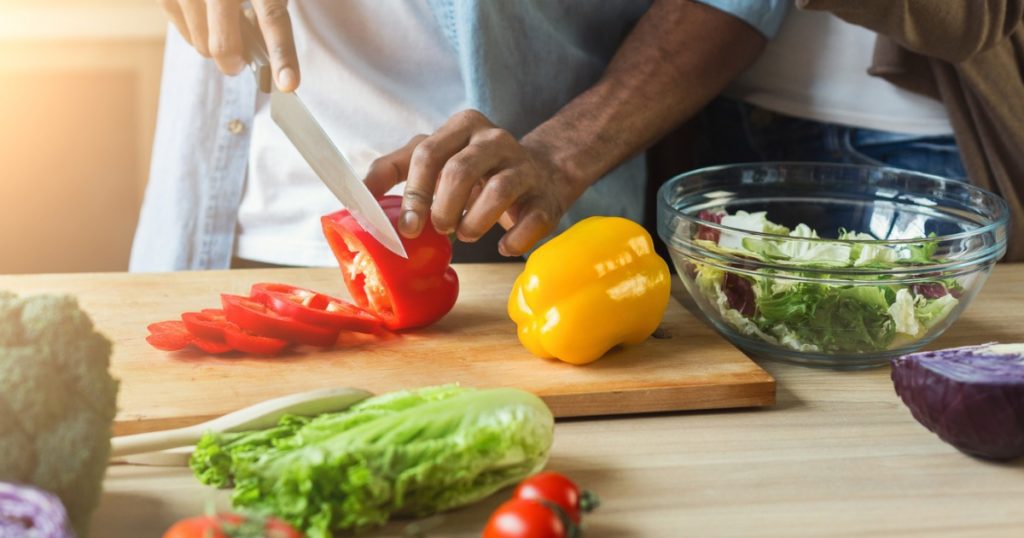
Share